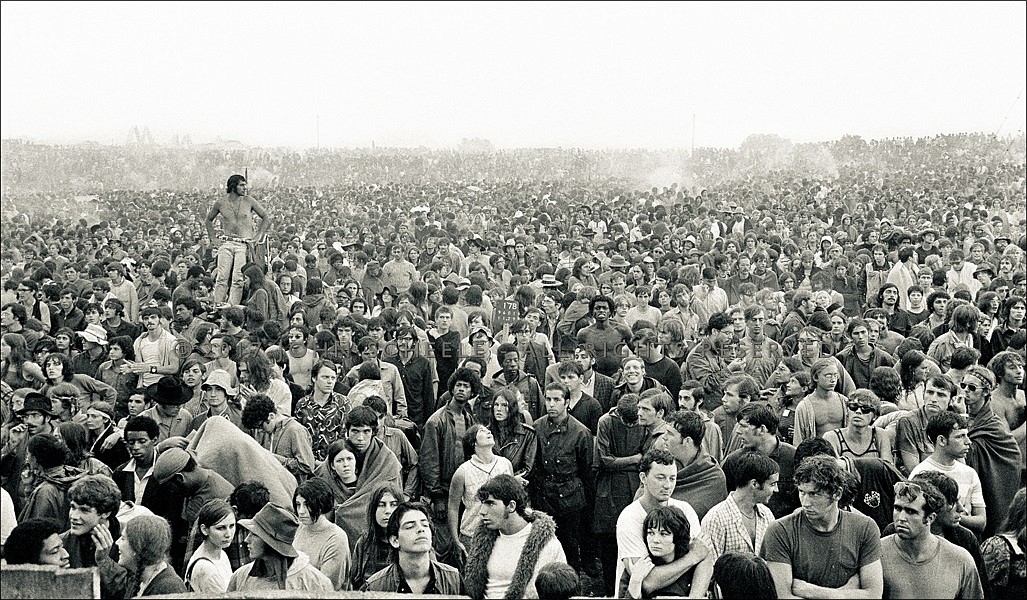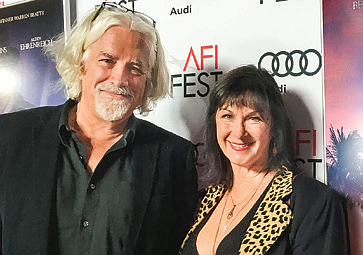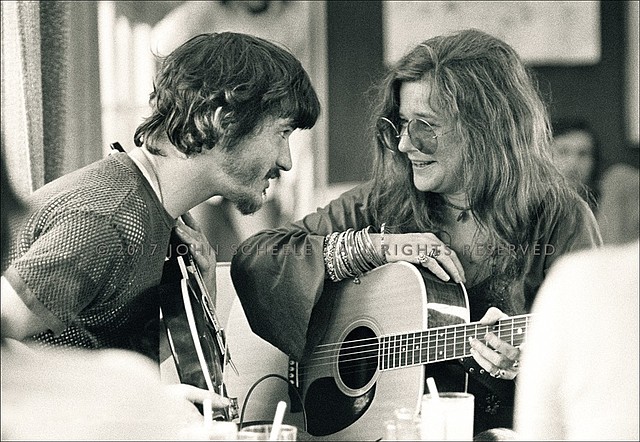Revisiting Woodstock with John Scheele
July 1, 2017 at 8:08 p.m.
“It was an amazing experience,” recalls part-time Northwesterner John Scheele of his time at Woodstock in August of 1969.
“Just after high school, I had the opportunity to join my brother Bill, who was working for The Band on their tours, and I jumped at the chance to go on the road that summer. Along the way, I took photographs constantly!”
John joined 500,000 mostly young people who gathered on Max Yasgur’s farm in upstate New York. They camped out and stood in the rain to hear Jimi Hendrix, Janis Joplin, The Band, Jefferson Airplane, the Grateful Dead, Joan Baez and other groups. They were some of the best artists of the time and became cultural icons – many of those musicians are still performing to this day.
“I remember the moment so clearly, walking out on the Woodstock Festival stage, going to the very edge to take in the size of the crowd. There was a constant drizzle – all those people pressed close together in rainbow colors with steam rising as the sun came out.
“Later, I wandered out and mixed with that sea of mud-caked humanity. There was never anything like Woodstock – it was a peaceful gathering that gave everyone hope that music and a spirit of love could make a difference in the world. On that last morning it was bittersweet as we started out in The Band’s red equipment truck.
I could see Jimi Hendrix in the passenger rear view mirror – he was the last performer – playing The Star Spangled Banner in a burst of prismatic color.”
Through the years, Woodstock remains more than a beloved music festival and became symbolic of an entire generation. All those young people arrived to hear music, but also to take a stand for peace and Planet Earth. There wasn’t any violence despite the crowd and improvised food and facilities – an enduring legacy for the Woodstock Generation.
For Woodstock’s 50th Anniversary in 2019, John, who works as a Hollywood visual effects supervisor, is planning an immersive virtual reality film to bring those historic three days back to life using his own photos as part of the recreation. John’s plans include using the latest film technology, which is nothing new for him. It’s been a major theme in his life story, and a unique part of his career that continues with his tribute to the 1969 Woodstock Festival.
John started Harvard University that fall and the next summer boarded the Festival Express – crossing Canada on a whistle-stop tour with Jerry Garcia, The Band and the great Janis Joplin. “She sat with us and told her life story – and then asked the train conductor to slow down, since none of us were in any hurry. She poured Southern Comfort for everybody to share – and Jerry offered up his own ‘private reserve’ too! It was a joyful party, with just the musicians and a few of us along to help out with the equipment.”
For John, these were not only exciting times, but an opportunity to develop his skill as a photographer. Some of his images were included by The Band and Bob Dylan on their album covers, including Stage Fright and The Basement Tapes. Rolling Stone magazine later featured his portrait of Levon Helm, The Band’s iconic drummer and vocalist, to honor his passing in 2012.
At Harvard, John had no inkling he’d wind up in Visual Effects. “That was not yet a career path in the 1960s.” But everything he learned moved him in that direction. His undergraduate degree was in Visual and Environmental Studies, and he later received a Master’s degree in Film & Video from California Institute of the Arts.
John’s parents had provided a home where art and nature were vital parts of daily life. “My parents were both superb artists and champions for the natural world. Although I could draw and paint at a certain level of skill, I had a better eye for camerawork and wanted to head off in a different direction from my parents.
“My father, William E. Scheele, was the long-time Director of the Cleveland Museum of Natural History. He helped set aside sensitive natural areas like Ice Age bogs and forests during those years. I met Rachel Carson and Justice William O. Douglas when they spoke on wildlife and conservation at museum events. Later, my father became head of the World Wildlife Fund and traveled to Sweden to expand that work.”
John’s parents taught their three sons respect for the natural world, its past and present, and its connection to the future. It was a daily lesson and created a reverence for nature that continues to inspire John. “My mother, Joann S. Scheele, was an editor and writer. For many years, she put together the Museum’s magazine, The Explorer, which focused on conservation issues. She used my crowd photo from Woodstock as one of her magazine covers, which meant a lot to me.”
Though photography and film became his career choice, environmental concerns remain a keen interest. That came easily to kids growing up in “Woodpecker Woods,” their 75-acre natural preserve in rural Ohio. With streams and an ancient forest to explore, John and his two brothers had the opportunity to observe nature – and learn to be patient. “I remember, as a four-year-old, slowly stalking a robin around the yard for hours on end until I could finally touch its tail.
“My love of nature is with me always. And like my father and grandfather, I became an avid collector, winning awards for my butterfly collection and even contributing a record-size Eastern Red Spotted Newt to the Museum’s permanent archive.”
One of John’s favorite things was watching his father create the Museum’s life-like exhibits and dioramas. That same kind of patience and attention to detail are necessary skills to be a first-rate visual effects artist. “It can take many years to research a film and develop its look,” John says. “It’s even more complicated than stalking robins!
“There was also an important element of teamwork at the Museum, with artists and scientific experts collaborating. I worked at the Harvard Museum during my years in Cambridge and that same group effort is a hallmark of filmmaking. Early on, Visual Effects was referred to as trick photography,” John explains. “It was already part of Trip to the Moon in 1902 by Georges Méliès. The Wizard of Oz, Citizen Kane and North by Northwest also used matte paintings and forced-perspective to create brilliant illusions. Those earlier films represent Hollywood magic at its best.”
An early landmark in John’s career was the 1982 film Tron. “That was a major breakthrough for visual effects – we used computers for the first time to create a digital world.” He went on to work on Dick Tracy, Blade Runner, Batman Returns and Mars Attacks, and became the first Vice President of Visual Effects at Warner Bros.
“I enjoyed making fantasy films, but then I had the opportunity to turn towards more realistic work.” John explains, “Director Oliver Stone posed the challenge of showing the World Trade Center attacks. That was a big one – and an emotional and humbling experience for me.” He teamed up with Oliver again on Alexander. “To recreate that ancient world and his battle scenes, we went to the top academics at Oxford University. I studied cast copies there of the very statues that Alexander restored to Athens when he toppled Babylon in 480 BC.”
John’s effects work was most recently seen in Rules Don’t Apply, which opened on Thanksgiving 2016: “It’s a story that centers on Warren Beatty playing Howard Hughes during the years he was becoming a mentally ill recluse. We painstakingly brought back 1958 Los Angeles and Las Vegas for this project, which had been gestating for almost 30 years. Warren proceeds at a very deliberate pace in developing a script.
“All these films required long and careful research to faithfully render an immersive period look. Frankly, this was much more satisfying than a simple fantasy film.”
And now John is combining his love of photography and expertise in visual effects for a new project. For most of us, family photos or home movies are irreplaceable keepsakes. They are the precious time-markers of our lives. Even if we don’t look at them often, we know they’re there, sitting in a drawer or on a shelf, holding real moments of our lives in suspension. How would you like to relive those moments in a new way – to have those memories experienced as part of your own virtual reality?
“It’s entirely possible,” claims John. “There’s a new hybrid technology that combines the large-screen impact of an IMAX film with advanced virtual reality headsets that see the world in 3D. You experience an overwhelming sense of “presence” within just a few minutes – it feels as though you are standing right there.” John will use this technology to celebrate the 50th Anniversary of the Woodstock Festival with an immersive virtual reality film to bring those remarkable days back to life.
John also has several other ideas in the works. He especially looks forward to developing projects in the Northwest on songwriting and music. “Seattle has a great music scene – and the Museum of Pop Culture might be a place to exhibit and take these projects further.” He believes these immersive virtual reality experiences will give people a new way to experience their history and offer a means to pass on their insights and knowledge.
John’s longtime girlfriend, Wendy Cutler, is an actress and voice-over artist. She worked with Robin Williams, John Ritter and Gary Shandling, among others, in her parallel career in Improv – starting in 1975 with the “Off The Wall” troupe. The couple now live part-time on Cottage Lake, and spend time with the frogs and bald eagles there. “The Northwest forests and wetlands are spectacularly beautiful – and remind me very much of my childhood in Ohio.”
John and Wendy intend to both continue their professional careers in Los Angeles and also express their creativity in the Northwest.
If you’d like to see more of John’s photos from the Woodstock period, John’s daughter Georgia helped create a website for his photos – you can start with this link: www.facebook.com/PhotographybyJohnScheele/.
Delores M. Dahl is a West Seattle native and now lives in Bothell. She is especially happy that John and Wendy will be spending more time in the Northwest, since Wendy is her daughter! Delores is a writer and retired Northshore school teacher, and author of “Rebel and The Promise” – a coming-of-age young adult historical novel she describes as “full of daring-do adventure circa 1860.”







